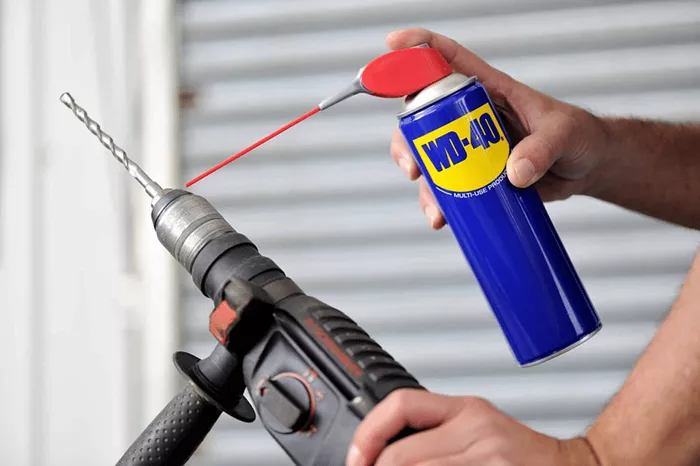Why Cleaning Grease is Important?
Power tools are essential for both professionals and DIY enthusiasts, but they require proper maintenance to function efficiently. Over time, grease accumulates on tools, attracting dirt and dust, which can reduce performance and even cause long-term damage.
Regular cleaning helps extend the life of your tools, improves efficiency, and ensures safety during operation. A clean tool also prevents grease buildup from spreading to work surfaces or interfering with precise tasks. Whether you’re working with drills, saws, grinders, or routers, keeping them free of grease ensures smooth operation and reliability.
Safety First: Precautions Before You Begin
Before you start cleaning, follow these essential safety steps:
1. Unplug the Tool
Always disconnect power tools before cleaning. For cordless tools, remove the battery. This prevents accidental starts, which could lead to injury.
2. Wear Protective Gear
Use the right protective equipment to avoid skin irritation or inhaling harmful fumes:
Gloves: Nitrile or grease-resistant gloves protect your hands.
Eye Protection: Safety glasses prevent debris or splashes from reaching your eyes.
Respirator (if needed): If using strong solvents, wear a respirator in poorly ventilated areas.
3. Read the Tool’s Manual
Different power tools have unique cleaning needs. Check the manufacturer’s instructions to avoid damaging sensitive components.
4. Ensure Proper Ventilation
When using degreasers or solvents, clean in a well-ventilated space to reduce exposure to harmful fumes.
Gathering Your Supplies: What You’ll Need
Cleaning Solutions
The right cleaner depends on the level of grease buildup. Here are different options:
1. Mild Soap and Water (For Light Grease)
Ideal for routine maintenance.
Use dish soap or an all-purpose cleaner with warm water.
2. Degreasers (For Medium Grease)
Commercial Degreasers: Simple Green, Purple Power, and citrus-based degreasers work well.
Household Alternatives: Baking soda paste, vinegar, or rubbing alcohol can be effective but may take longer.
3. Solvents (For Heavy Grease)
Mineral Spirits: Removes thick grease but should be used cautiously.
WD-40: Works as a degreaser but must be wiped off completely.
Brake Cleaner: Highly effective but toxic and flammable. Use only in well-ventilated areas.
Tools for Cleaning
Brushes: Nylon brushes for gentle cleaning, wire brushes for tough grease.
Rags/Cloths: Microfiber cloths are ideal for wiping away grease.
Scrapers: Plastic or rubber scrapers remove thick grease without scratching surfaces.
Compressed Air: Helps remove dust and moisture.
Screwdrivers/Wrenches: Needed if you disassemble parts for deep cleaning.
Step-by-Step Cleaning Instructions
General Cleaning (Mild Grease)
Unplug the tool and put on gloves and safety glasses.
Wipe the exterior with a damp cloth and mild soap.
Use a brush to scrub away any remaining grease.
Rinse with a clean cloth and remove excess moisture.
Dry thoroughly using a clean rag or compressed air.
Deep Cleaning (Heavy Grease)
Unplug the tool and remove the battery (if applicable).
Disassemble removable parts (only if comfortable doing so).
Scrape away thick grease deposits with a plastic scraper.
Apply a degreaser to the affected areas and let it sit.
Scrub with a brush to remove loosened grease.
Wipe down with a clean cloth to remove residue.
Repeat if necessary for stubborn grease.
Rinse (if applicable) and dry completely with compressed air.
Reassemble the tool and ensure all parts are secure.
Lubricate moving parts according to the manufacturer’s recommendations.
Specific Tool Considerations
Each tool has unique cleaning needs:
Drills/Impact Drivers: Clean the chuck and motor housing thoroughly.
Circular Saws/Jigsaws: Pay attention to the blade and blade guards.
Sanders: Remove built-up dust and grease from the motor and base.
Angle Grinders: Clean around the spindle and protective guards.
Routers: Focus on the collet to ensure a firm grip on bits.
Stubborn Grease Removal Tips
1. Soaking
For extreme grease buildup, remove parts and soak them in a degreaser for a longer period.
2. Applying Heat (With Caution)
A heat gun (on a low setting) can help loosen grease.
Do not overheat, as this can damage plastic components.
3. Using an Ultrasonic Cleaner
Small removable parts can be cleaned using an ultrasonic cleaner.
This method is effective for grease removal in tight spaces.
Maintenance: Preventing Future Grease Buildup
To keep your power tools in top condition, follow these maintenance tips:
Wipe tools after every use: This prevents grease from hardening.
Store in a clean, dry place: Avoid exposing tools to excessive dust and moisture.
Lubricate as needed: Use only recommended lubricants to keep moving parts functioning properly.
Disposal of Cleaning Supplies
Improper disposal of cleaning products can harm the environment. Follow these steps:
Used rags : Dispose of oily rags in a sealed metal container to prevent fire hazards.
Degreasers and solvents: Follow local regulations for hazardous waste disposal.
Empty containers: Check recycling rules for plastic and metal containers.
Conclusion
Cleaning grease off power tools is an essential part of tool maintenance. By following the right steps and using appropriate cleaning methods, you can ensure that your tools remain in excellent condition for years. Regular maintenance not only improves performance but also enhances safety, making every job smoother and more efficient.
By incorporating these cleaning techniques into your routine, you’ll extend the lifespan of your power tools and keep them working like new!
Related topics:
- 4 Best Electric Pressure Washers
- What Are the 3 Classifications of Power Tools?
- Where Are Makita Power Tools Made?

